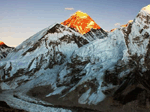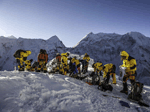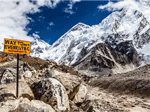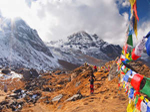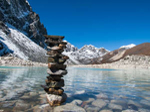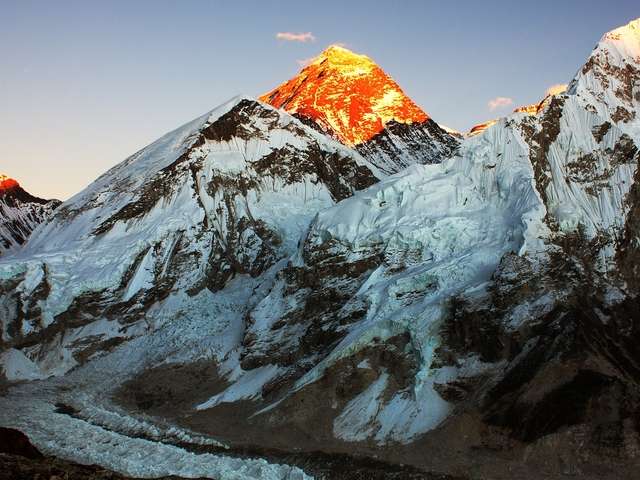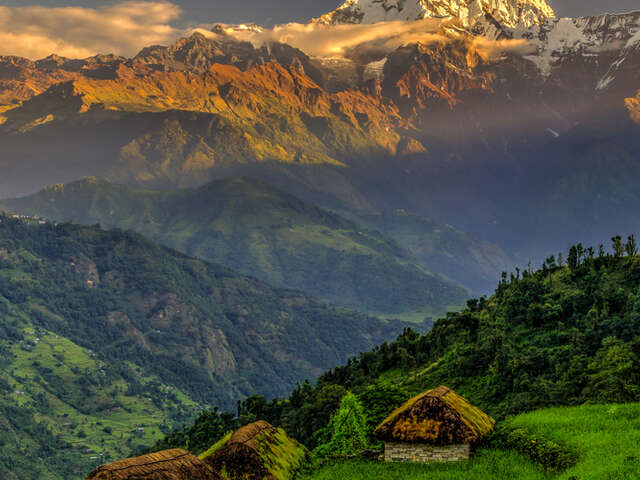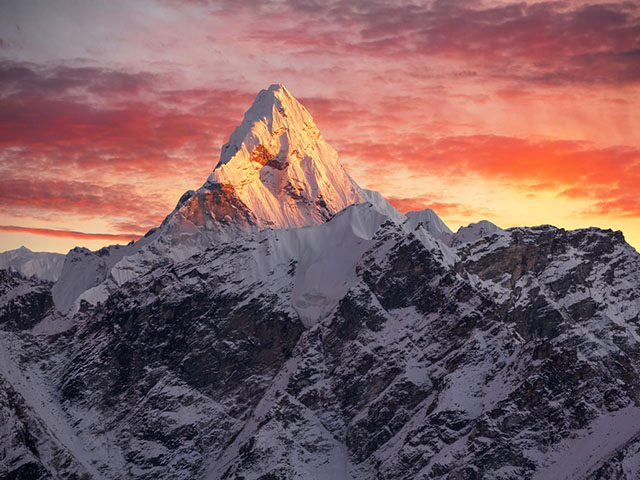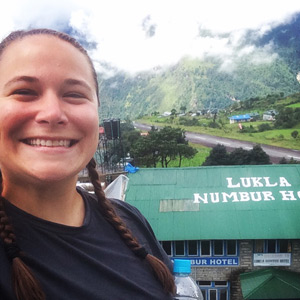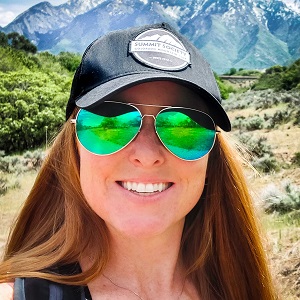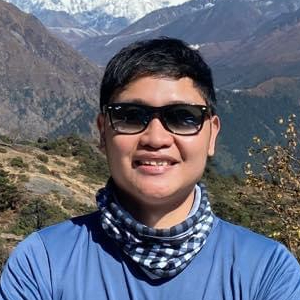
Are you preparing to trek Everest Base Camp or another tea house trek in Nepal? If so, you may be looking for a comprehensive packing checklist. Packing the proper clothing, equipment, and supplies for your Everest Base Camp trek will go a long way in ensuring you have a great trekking experience.
As you pack for Everest Base Camp, remember that your gear will be divided into two packs: your daypack that you will carry each day as you trek, and your duffle bag which will be carried between tea houses by porters. All extra luggage can be left at the hotel before you begin your trek.
At the start of every morning, your porters will take your duffle and carry it up to the next tea house. It will be difficult or impossible to access your gear from your duffle bag until the evening when you arrive at your tea house. This means you should pack anything you may need each day during your hike in your daypack. However, to make trekking easier, you should keep your daypack as light as possible—so only carry the essentials. This includes water, snacks, camera, headlamp, poncho, extra layers, and sun protection.
Everest Base Camp Packing List
This list is a comprehensive Everest Base Camp packing list. It includes the layers you should bring to ensure you’re warm during the climate fluctuations of the Himalayan region, gear to make your trek accessible and comfortable, and supplies to help you have the best experience possible.
If you have questions about this packing list or have any other questions about trekking Everest Base Camp, please reach out to our Adventure Specialists today!
If you have questions on what you might need just ask us and keep in mind that Kathmandu is a great place to buy trekking gear at affordable prices.
You can download the complete packing list here:
Everest Base Camp Packing List
If you prefer a word document click here
Clothing
- Moisture-wicking long-sleeve t-shirts (2)
- Moisture-wicking short-sleeve t-shirt (1)
- Heavy fleece or down jacket
- Gortex or waterproof jacket with hood
- Windbreaker
- Rain poncho
- Fleece pants
- Trekking pants (2)
- Hiking shorts (1)
- Waterproof pants
- Hiking socks (10)
- Warm thermal socks (1)
- Long underwear (2)
- Underwear (10)
- Hiking boots with ankle support
- Camp shoes or tennis shoes
- Light inner gloves/glove liners
- Insulated wool or down mittens/gloves
- Sunglasses
- Broad-brimmed hat
- Neck gaiter or bandana (for sun protection)
- Wool hat or balaclava (should cover ears)
- Gaiters (needed Dec-Feb)
- Sweatshirt (optional)
- Sock liners (optional)
Trekking Gear & Supplies
- Duffle bag for carrying gear via porters (provided by Himalayan Wonders if you’re trekking with us)
- 40L Daypack for carrying what you need on the trail
- Waterproof cover for daypack
- Water bottles or hydration bladder (i.e. CamelBak)
- Sleeping bag rated to -18°C/ 0°F (available for rental if you’re trekking Everest Base Campthrough Himalayan Wonders)
- Trekking poles
- Headlamp with extra batteries
- Lightweight water filter or iodine water tablets (personal preference)
- Hand warmers
- Travel pillow or pillowcase
- Sleeping bag stuff sack
- Drybags in several sizes
- Stuff sacks for dirty clothes/shoes
- Camera with extra batteries and memory cards
- Small lock(s) for duffle bag and daypack
- Sleeping bag liner (optional)
- Quick-drying trekking towel (optional)
Food & Snacks
- Snacks (combine protein & carbs for well-balanced energy)
- Thermos (optional for hot beverages)
- Re-hydration gels or powder
Toiletries
- Sunscreen
- Lip balm with sunscreen
- Toilet Paper
- Moleskin, medical tape, and/or duct tape for treating/preventing blisters
- Advil or Ibuprofen
- Diamox (for altitude sickness)
- Personal prescriptions
- Antibiotics (Cipro for travelers’ diarrhea)
- Anti-chafe balm (e.g. Body Glide, to prevent chafing)
- Diaper rash cream (Can treat rashes or chaffing)
- Soap
- Deodorant
- Toothbrush/toothpaste
- Razor (as needed)
- Shampoo
- Wet wipes
- Hand sanitizer
- Feminine hygiene products (as needed)
- Face lotion
- Hairbrush
- Hair ties
- Earplugs (for sleeping)
Additional Supplies
- Portable solar charger/power bank
- Book
- Journal/pen
- Playing cards
Important Documents
- Passport (needed at entry gate for registration)
- Visa (these are easy to attain when you land in Kathmandu—bring $30 (15 Days) or $50 (30 Days) USD for Visa Application
- Money ($200-300 cash is recommended—while there are occasional ATMs on the trail, they are almost always out of order)
- One passport-sized photo if trekking in the Annapurna Region (needed at times for trekking permit). Not needed for Everest Treks.
- Travel insurance

Packing Clothes for Layering for Everest Base Camp
Layering is important when you’re trekking Everest Base Camp. As elevation changes and night falls, you’ll experience temperature fluctuation. If you are going in March, April or October you should expect fairly good weather and may even find yourself trekking in shorts and a t-shirt at the lower elevations. However, as you gain elevation it gets progressively colder and base camp can be below freezing any time of year. It’s best to come prepared for cold weather and bring those a few extra layers just in case. Layering your clothing lets you easily regulate your body temperature by adding or removing layers or simply unzipping.
The base layer is the first layer of clothing you should put on. This is an important layer in the cold as it helps your body maintain a steady temperature by providing extra insulation and wicking away perspiration.
Look for fabrics like Capilene or Merino Wool. Avoid cotton as cotton materials will absorb moisture and defeat the purpose of the base layer.
A middle layer serves as your insulating layer. The best option for your middle layer on the Everest Base Camp Trek is a thick down jacket or fleece jacket. Find a jacket that is easy to zip and unzip so you can more easily regulate temperature without having to take the jacket off or put it back on as temperatures fluctuate.
Your outer shell layer protects you from elements. The best material for your outer shell layer is Gortex which is both breathable and waterproof. A nylon jacket or a plastic poncho is a cheaper alternative but the downside is that these materials trap moisture which makes it more difficult for your body to regulate temperature.
Packing Hats, Gloves, and Gaiters for Everest Base Camp
In warm, sunny weather, a wide-brimmed hat is recommended to protect your face from the sun. In colder temperatures, you should bring a wool hat or Balaclava that covers your ears. Sun protection is important at high altitudes, so supplement your hat with face sunscreen, sunglasses, and a bandana or neck gaiter to protect against the sun’s rays.
With gloves, it’s also important to apply the principle of layering. Bring a lightweight glove or glove liner as well as heavier wool or down gloves. The liners can be worn without insulated gloves on top when it’s cool weather but not cold enough for thick gloves. When temperatures drop, these liners can be worn underneath heavier wool or down gloves or mittens to help provide added insulation.
Thin gloves or liners are can keep your skin protected from chilly air when performing tasks such as tying shoelaces.
Gaiters are recommended when you’re traveling December through February but can also be useful at other times on the trail. Gaiters cover the ankle-high opening of your boots and up your calves. This prevents snow, water, mud, rocks, or dust from getting into your shoes.While it’s highly unlikely you will be walking through snow, it does occasionally happen. Gaiters are also great to help protect your clothing and feet from gathering dust on the trail.

Which Hiking Boots to Wear for Everest Base Camp
The best option for footwear on the Everest Base Camp Trek is to bring a pair of broken-in hiking boots for the trek. You should also bring a lighter weight shoe that you can wear in the evening after trekking.
Your choice for footwear depends on your personal preference and if you usually hike in tennis shoes then you can probably do the same going to base camp as the trail is fairly level without a lot of rocks. The downside of tennis shoes is they don’t provide any ankle support and they are not as warm as hiking shoes.
Having comfortable, broken-in shoes is extremely important. While you can get plenty of hiking gear in Kathmandu for cheap before your Everest Base Camp trek, we recommend purchasing your hiking boots at home beforehand with plenty of time to break them in ahead of time.
Buying boots that are too small is one of the most common mistakes people make when packing for Everest Base Camp. Ideally, your hiking boot should have extra room for socks but not be so loose-fitting that your heel slips while you are walking.
If you start to get a blister or your feet are uncomfortable, it’s best to stop and take care of the situation before it becomes a real problem. Try a lightweight sock-liner in addition to heavier socks or wear two pairs of cotton sock to minimize friction. If this does not solve the problem, place some duct tape or moleskin over the area where a potential blister might develop.
The best option for socks is a combination of wool socks and lightweight sock liners made of a material like Capilene. Cotton socks will work as well, but you should make sure that you bring a fresh pair for every day. A good rule of thumb is to bring enough underwear and socks to change them every day even if you wear the same pants the entire trek.
If you are doing the Gokyo and Everest Trek or the Three Passes treks, micro-spikes are recommended for crossing the passes. Although highly unlikely during the peak trekking months, there is ALWAYS a possibility of snow and ice on any of the treks in Nepal. Most likely these will not be used but picking up a pair of these will help you prepare for the worst. These are simple slip-on spikes that attach securely to your footwear and require no special buckles or straps to attach (not to be confused with crampons).
Which Type of Sleeping Bag to Bring for Everest Base Camp
Although you will be sleeping in tea houses, these accommodations get very cold at night and warm bedding is typically not provided. Your best bet is to bring your own sleeping bag or to purchase one in Kathmandu.
Himalayan Wonders offers rental sleeping bags for $20 USD when you trek with us. (You may also rent down jackets from us for $15 on request). Tea houses along the trail will provide a mattress covered by a sheet as well as a pillow. You may also ask for an extra blanket in most cases if you need it to cover your sleeping bag.
Choose a high-quality sleeping bag that is rated to -18°C/ 0°F. We also recommend bringing a travel pillow or pillowcase for improved personal hygiene.
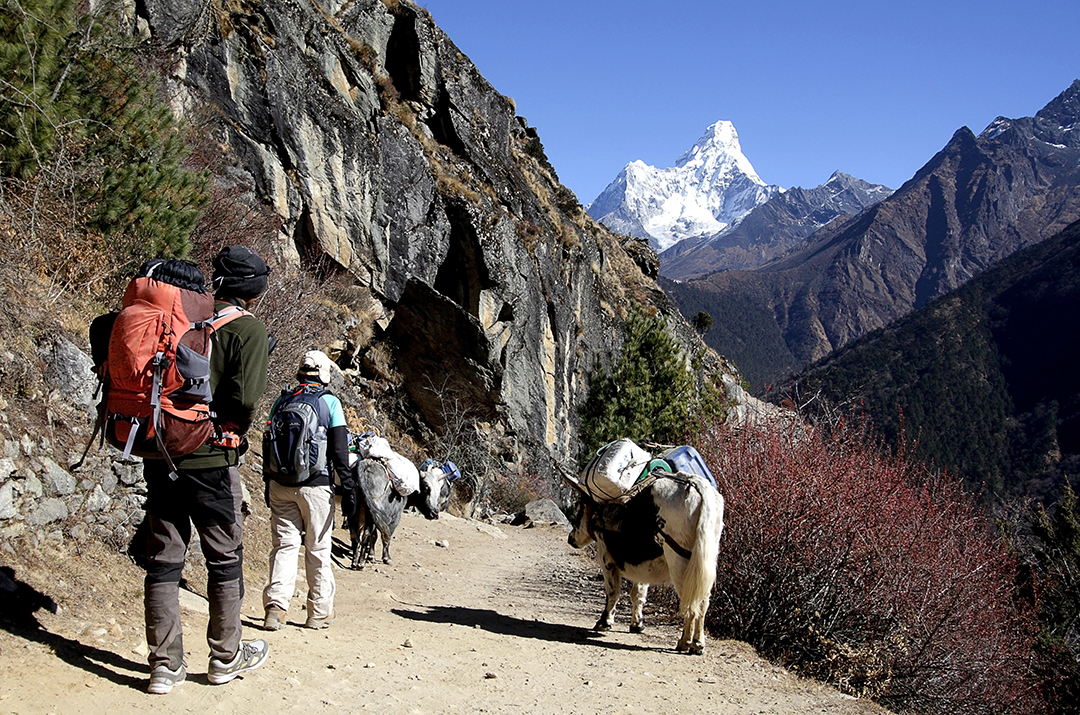
Carry Your Gear
The flight from Kathmandu to Lukla has strict weight limits, which means at this portion of the trip you should only bring what you will use on the trek. You’re allowed to bring a main pack (duffle bag) which can weigh 10kg (22lbs). When you trek with Himalayan Wonders, this pack is the duffle bag provided by our company and is the pack the porters will carry up the mountain. You should also bring a carry-on (daypack) that is 5kg (11lbs) or less.
We also suggest bringing several dry bags inside your duffle for packing shoes, wet clothes, or dirty laundry.
What Toiletries Should You Pack for Everest Base Camp?
When you’re packing toiletries, remember that you have weight constraints for the airplane to Lukla and for porters. Bring the essentials and bring only as much as you need. When you trek with Himalayan Wonders, our team carries first aid kit on the trek, but there are some items you should plan on packing, including Tylenol/Ibuprofen, Diamox, blister treatments, and more. See above for our comprehensive packing list for Everest Base Camp.
Paperwork and Money
You should bring enough money to buy snacks and beverages along the way, as well as any toiletries or other items you may have forgotten to pack. Along the Everest Base Camp trail, you can find a single ATM in Namche, but don’t count on it working. If you had a great time your porters and guide will appreciate a tip which is best given in Lukla at the end of the trek before you fly back to Kathmandu.
Gear You Can Buy in Kathmandu
Don’t have all the gear you need on the Everest Base Camp packing list? Kathmandu can be a great place to buy good quality, inexpensive gear. See our tips on buying gear in Kathmandu. However, we do not recommend purchasing hiking shoes in Kathmandu before your trek as you should allow plenty of time to break in your shoes beforehand—nothing dampens a trek faster than sore, blistered feet!
Nepal is a great place to buy new trekking gear and equipment. Because of the trekking community in the region, you can find virtually everything you might need for the trek at an affordable price. However, you should be careful to avoid cheap knockoffs.
Before you purchase any items, make sure the zipper works and is of sturdy construction. Also, take a look at the stitching and make sure it is even, of good quality, and is not separating. If you are buying a pack, pay particular attention to where the straps attach to the pack—make sure it’s well stitched and strong.
If you want brand name gear or top-quality items then Kathmandu might not be the place to buy these items, but if you want to save a lot and have some pretty good equipment it’s a great option.
What Are We Forgetting?
The great thing about tea house trekking is that you if forgot something you can easily buy it along the way. Namche Bazaar, which you reach on the second evening of the trek, has numerous shops selling sporting goods and souvenirs. Namche Bazaar also hosts several pharmacies and bookstores.
If you happen to be traveling through Namche on a Saturday morning, you can check out the weekly market when local Sherpas from surrounding villages set up in the middle of town and exchange everything from electronics to sporting goods.
Further along the trek, you will find a few other places to buy things like jackets, medicine, snacks, and books but the selection is nowhere as good. Keep in mind that the higher you get on the mountain the more expensive prices will get. Your best option is to purchase in Kathmandu anything you may have forgotten to pack!
This post was originally published in July 2018 and was updated January 2020.
